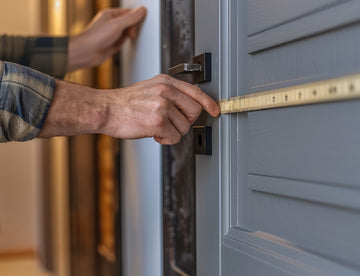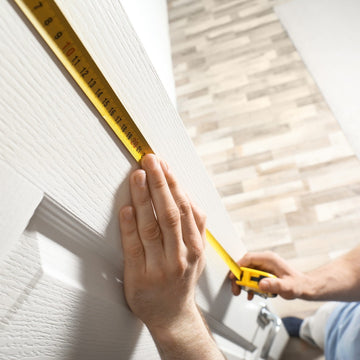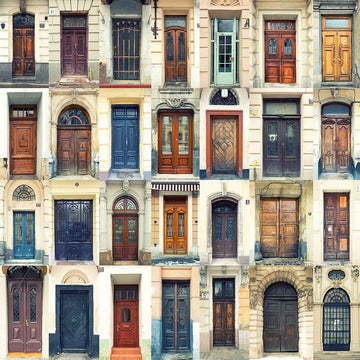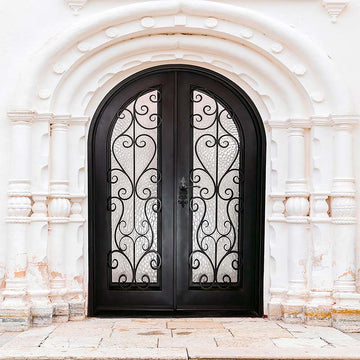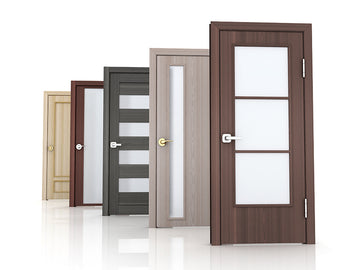
Your door greets visitors, frames your personal style, influences energy use, and contributes to your home's value. Because it's so important, you may pause at the decision between fiberglass vs. wood doors, unsure which aligns best with your long-term goals.
Being fully informed about both materials prepares you to invest in a door that enhances your property and stands strong against the elements. Keep reading for a detailed comparison of wood vs. fiberglass doors.
Understanding the Basics: Fiberglass and Wood Doors
Fiberglass doors feature reinforced skins over insulating foam cores, delivering stability, durability, and reliable insulation. Fiberglass can come in finishes that closely resemble high-quality wood, blending authentic charm with modern performance.
On the other hand, wood doors crafted from solid hardwood or engineered veneers provide a sense of warmth and tradition. When properly maintained, many wooden doors last for decades.
|
Feature |
Fiberglass Doors |
Wood Doors |
|
Composition |
Fiberglass skins over foam core |
Solid hardwood or engineered veneers |
|
Durability |
Resists warping, cracking, and swelling |
Needs sealing and refinishing to handle weather |
|
Maintenance |
Minimal upkeep with occasional cleaning |
Periodic refinishing or sealing |
|
Energy Efficiency |
Often top-tier, thanks to tight seals and foam cores |
Good insulation but works best with proper sealing |
|
Cost |
Moderate upfront and lower long-term expenses |
Higher initial cost, although this varies by species and quality |
Advantages of Fiberglass Doors
Fiberglass doors stand out for homeowners who value longevity and simplicity. The structure resists common issues such as moisture seepage or temperature-induced warping. Finishes can typically endure intense sunlight, salty coastal air, regular rainfall, and wide temperature swings without losing appeal.
Many fiberglass options arrive prefinished or primed, and weatherstripping and insulated cores help stabilize indoor temperatures, resulting in lower utility bills. According to the U.S. Department of Energy, a 1-1/2 inch thick fiberglass door without a window boasts five times the insulating value of a solid wood door with the same dimensions.
Consider fiberglass if you want:
- A door that endures tough weather with ease
- Lower ongoing maintenance and fewer weekend refinishing projects
- Energy savings supported by insulated cores and quality seals
- Styles that mimic woodgrain or embrace modern aesthetics
- Peace of mind knowing your door requires minimal daily attention
Advantages of Wood Doors
Wooden doors appeal most to those who appreciate subtle details and rich character. Each species, from oak to mahogany and eco-friendly bamboo or redeemed wood, has distinct color variations, textures, and timeless appeal. You can sand, stain, or paint wooden doors to match evolving tastes, making it easy to adjust the look as decor trends evolve.
Consider wood if you value:
- A natural, organic feel that becomes more beautiful as years pass
- The option to refresh or restyle through custom finishes
- Traditional warmth that complements both classic and contemporary homes
- A sense of craftsmanship, where the door's character enhances a home's overall aesthetic
- A long-term investment that can last for generations
Key Factors: Durability, Aesthetics, Maintenance, Energy Efficiency, and Cost
Choosing between fiberglass vs. wood doors requires careful thought. Let's take a look at some important considerations.
Durability and Weather Resistance
Fiberglass doors stand firm when challenged by coastal moisture or scorching summers. The Fenestration and Glazing Industry Alliance (FGIA) notes fiberglass' stability under varying weather conditions. Although inherently strong, wood requires sealing and refinishing to maintain its structural integrity. Those living in damp regions can still choose wood, provided they're willing to schedule regular protective treatments.
Aesthetics and Design Options
Many homeowners prefer the natural elegance of wood and how it complements large entryways, intricate trim, vintage lighting, and distinctive porch details. Fiberglass competes through advanced finishes that resemble high-end wood species while allowing bolder color experimentation.
Maintenance Requirements
Some people enjoy the hands-on approach — light sanding and a dash of carefully chosen stain — finding it rewarding to nurture wood's natural appeal. Others prefer a door that demands less attention. Fiberglass wins on simplicity. A gentle wash now and then keeps it looking new.
Energy Efficiency and Insulation
Fiberglass doors usually have insulated cores and excellent weatherstripping, blocking drafts that raise heating and cooling costs. Wood can insulate effectively when properly fitted, sealed, and maintained. Installing weatherstripping or adjusting hinges helps wood compete in efficiency, although fiberglass takes the lead in this category.
Cost Considerations
Initial costs vary. Fiberglass tends to land in a moderate range, with savings emerging through reduced maintenance and energy use. Wood starts higher, especially if rare or exotic species catch your eye. Many feel comfortable investing more upfront to gain a one-of-a-kind entrance that enhances curb appeal.
Before committing, consider whether you'll have the time and resources for maintenance or if a lower-effort option makes more sense.
Fiberglass vs. Wood Doors: Final Thoughts
Fiberglass and wood both make exceptional doors, so reflect on what resonates most with you. Some prioritize low-maintenance living, savoring weekends free from projects. Others embrace hands-on home care, cherishing a door that evolves with the home's character. There's no right or wrong—only the solution that best fits your values and personal style.
For guidance tailored to your situation, explore AAA Doors. Knowledgeable experts can recommend models that align with local climates, personal tastes, and long-term priorities.


